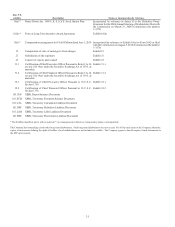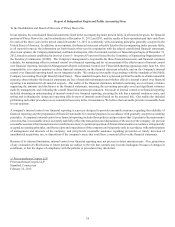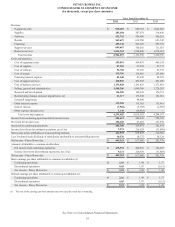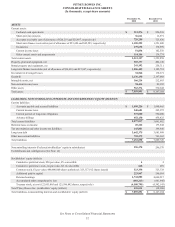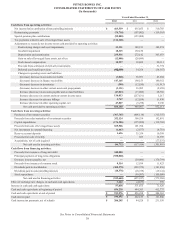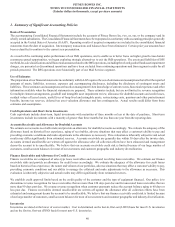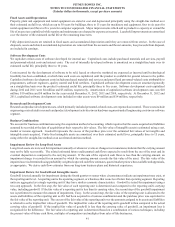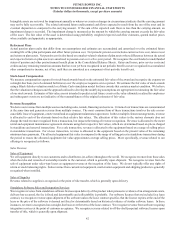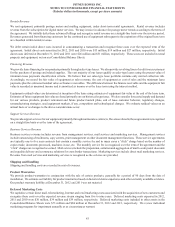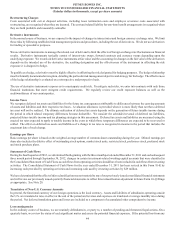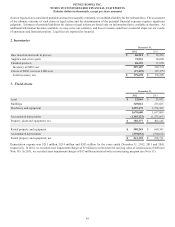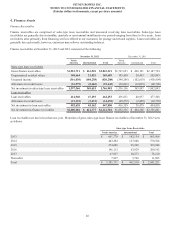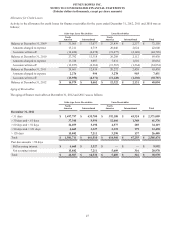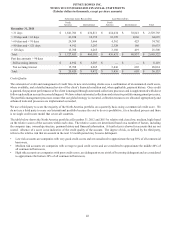Pitney Bowes 2012 Annual Report Download - page 59
Download and view the complete annual report
Please find page 59 of the 2012 Pitney Bowes annual report below. You can navigate through the pages in the report by either clicking on the pages listed below, or by using the keyword search tool below to find specific information within the annual report.PITNEY BOWES INC.
NOTES TO CONSOLIDATED FINANCIAL STATEMENTS
(Tabular dollars in thousands, except per share amounts)
41
Fixed Assets and Depreciation
Property, plant and equipment and rental equipment are stated at cost and depreciated principally using the straight-line method over
their estimated useful lives, which are up to 50 years for buildings, three to 15 years for machinery and equipment, four to six years for
rental equipment and three to five years for computer equipment. Major improvements which add to productive capacity or extend the
life of an asset are capitalized while repairs and maintenance are charged to expense as incurred. Leasehold improvements are amortized
over the shorter of the estimated useful life or the remaining lease term.
Fully depreciated assets are retained in fixed assets and accumulated depreciation until they are removed from service. In the case of
disposals, assets and related accumulated depreciation are removed from the accounts and the net amounts, less proceeds from disposal,
are included in earnings.
Software Development Costs
We capitalize certain costs of software developed for internal use. Capitalized costs include purchased materials and services, payroll
and personnel-related costs and interest costs. The cost of internally developed software is amortized on a straight-line basis over its
estimated useful life, principally three to 10 years.
Costs incurred for the development of software to be sold, leased or otherwise marketed are expensed as incurred until technological
feasibility has been established, at which time such costs are capitalized until the product is available for general release to the public.
Capitalized software development costs include purchased materials and services and payroll and personnel-related costs attributable to
programmers, software engineers, quality control and field certifiers. Capitalized software development costs are amortized generally
on a straight-line basis over the product's estimated useful life, principally three to five years. Software development costs capitalized
during 2012 and 2011 were $4 million and $5 million, respectively. Amortization of capitalized software development costs was $10
million, $10 million and $8 million for the years ended December 31, 2012, 2011 and 2010, respectively. At December 31, 2012 and
2011, capitalized software development costs included in other assets were $9 million and $14 million, respectively.
Research and Development Costs
Research and product development costs, which primarily included personnel-related costs, are expensed as incurred. These costs include
engineering costs related to research and product development activities in our hardware segments and all engineering costs in our software
segment.
Business Combinations
We account for business combinations using the acquisition method of accounting, which requires that the assets acquired and liabilities
assumed be recorded at the date of acquisition at their respective fair values. The fair value of intangible assets is estimated using a cost,
market or income approach. Goodwill represents the excess of the purchase price over the estimated fair values of net tangible and
intangible assets acquired. Finite-lived intangible assets are amortized over their estimated useful lives, principally three to 15 years,
using either the straight-line method or an accelerated attrition method.
Impairment Review for Long-lived Assets
Long-lived assets are reviewed for impairment annually or whenever events or changes in circumstances indicate that the carrying amount
may not be fully recoverable. The related estimated future undiscounted cash flows expected to result from the use of the asset and its
eventual disposition is compared to the carrying amount. If the sum of the expected cash flows is less than the carrying amount, an
impairment charge is recorded for an amount by which the carrying amount exceeds the fair value of the asset. The fair value of the
impaired asset is determined using probability weighted expected cash flow estimates, quoted market prices when available and appraisals,
as appropriate. We derive cash flow estimates from our long-term business plans and historical experience.
Impairment Review for Goodwill and Intangible Assets
Goodwill is tested annually for impairment during the fourth quarter or sooner when circumstances indicate an impairment may exist, at
the reporting unit level. A reporting unit is the operating segment, or a business that is one level below that operating segment. Reporting
units are aggregated as a single reporting unit if they have similar economic characteristics. Goodwill is tested for impairment using a
two-step approach. In the first step, the fair value of each reporting unit is determined and compared to the reporting unit's carrying
value, including goodwill. If the fair value of a reporting unit is less than its carrying value, the second step of the goodwill impairment
test is performed to measure the amount of impairment, if any. In the second step, the fair value of the reporting unit is allocated to the
assets and liabilities of the reporting unit as if it had been acquired in a business combination and the purchase price was equivalent to
the fair value of the reporting unit. The excess of the fair value of the reporting unit over the amounts assigned to its assets and liabilities
is referred to as the implied fair value of goodwill. The implied fair value of the reporting unit's goodwill is then compared to the actual
carrying value of goodwill. If the implied fair value of goodwill is less than the carrying value of goodwill, an impairment loss is
recognized for the difference. The fair value of a reporting unit is determined based on a combination of various techniques, including
the present value of future cash flows, multiples of competitors and multiples from sales of like businesses.


